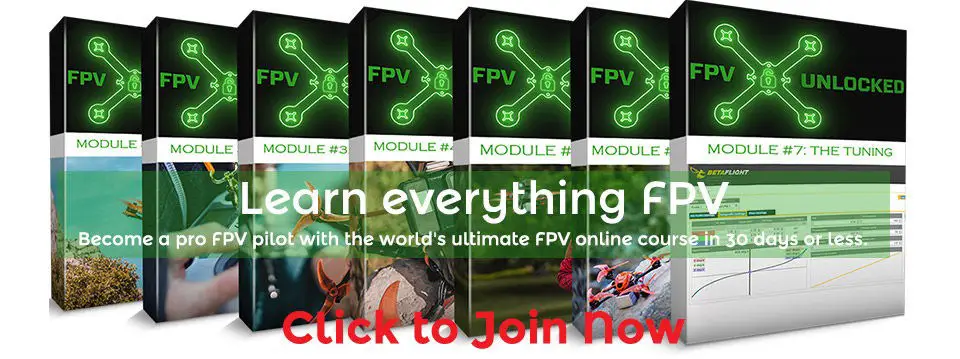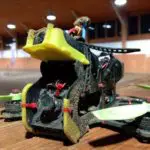FPV drone racing is competitive. We all want to win races but how? I’ve listed 9 tips and tricks that you should incorporate into your training routine or flight regime so that you have higher chance to win FPV drone races. Let’s see what are they.

- 1. Find Your Best Racing Line to Win the Race
- 2. Refrain From Overtaking If That Means Leaving Your Best Line
- 3. Watch Your Flight Recording
- 4. Keep Your Camera at High Angle
- 5. Be Strategic and Know When To Be Conservative
- 6. Practice With Other People
- 7. Join Drone Racing Competitions to Gain More Exposure
- 8. Practice Mindfully
- 9. Have Fun During Practice
- Final Thoughts
- Additional Information

1. Find Your Best Racing Line to Win the Race
Traditional races such as a car race have obvious tracks that you need to complete. Drone racing is similar but the track doesn’t have visible or clear boundaries. Instead, you fly your drone based on your own path to pass the required checkpoints.
The racing line, or simply, the line, is basically the most optimum path that allows you to complete the track in the shortest time. It might not be the shortest path, but it is definitely the fastest path that can lead you to victory.
Most novices don’t pay attention to the racing lines, unlike the pro racers. In fact, the racing line might be a totally new concept for you. But it’s an important factor in racing that you should practice early on so you can optimize your line as you go.
Generally, there are two types of line styles in drone racing that you should know about. I unashamedly use the same terms coined in this article by Aaron Ziemann: the point-and-shoot lines and the fast-and-fluid lines. These styles have their own different uses and under them, a couple more line techniques depending on the section of the track that you’re about to go through.

In its essence, point-and-shoot lines prioritize maximizing the entry and exit speed. However, it takes more effort and time to change the direction because you need to do a sharp turn. But as you turn, you can clearly see the gate and ramp your throttle towards it.
On the other hand, fast-and-fluid lines are about maintaining the average speed all throughout the turn. However, the gate visibility is compromised. I personally think the hardest part here is to gauge the location of the gate when you turn, since the camera can only see the front and there is no visible line to guide you.
There’s no one technique solution for races. Different techniques may be suitable for different people, and each has different advantages under different conditions.
You need to experiment and find out which is your “style”, and you will probably stick to that “style” predominantly. For instance, my personal favorite is the point-and-shoot style and I use it most of the time. However, you should be familiar with both techniques so that you can switch your strategies according to the situation.
During your practice, make the effort to take note of different ways you can tackle an obstacle or turn. In drone races, pilots are usually allowed to have two practice runs to get the feel of the race track.
Remember, you are flying in the air and you can move in 3 directions. Sometimes you can make use of the gravity to enter the gate slower or exit the turn faster.
2. Refrain From Overtaking If That Means Leaving Your Best Line
There’s always a rush that makes you feel incredible whenever you overtake a foe during races. But the thing is, overtaking just for the sake of overtaking isn’t really the best race strategy. Especially if that means ruining your race techniques.
My advice? Go slow so you can go fast. While that might not make sense since it’s contradictory, you have to remember the essence of drone racing. Just because you’re ripping through the track at full throttle, that doesn’t mean that you’re actually flying the track fast enough to win.
Drone racing is strategic. Keeping tight to your racing lines and having smooth turns will impact your race more than throttling and overtaking without control.
Of course, having restraint might not be the easy thing to do, especially if you’re pumped up on racing adrenaline. The key thing to do is to practice in groups more often and try to always stay calm.
3. Watch Your Flight Recording
There’s a reason why it’s almost customary in sports to film practice sessions and even the match itself. Because it doesn’t matter how much you feel that you’ve improved, unless you have solid proof that your techniques are getting better, you won’t have a great sense of your own progress.
Watching your flight recording is one of the simplest and most effective things that you can do. Especially when it comes to perfecting your lines. Like we’ve said, finding your best line is an experimental thing. Having a recording to refer to makes it easier and more effective whenever you’re doing a study session for self-evaluation.
Watching your own recordings will also give you a great sense of practicing mindfully! During your practice runs, you want to know what exactly you’re practicing for and not just doing it so you can tell yourself that you’ve been practicing. Remember that it’s all about improving yourself at your own pace!
4. Keep Your Camera at High Angle
The drone’s camera angle is adjusted according to the pilot’s preference. It’s a very personal setting and it is basically one of the few things that set you apart from other pilots.
The angle of your drone camera is pretty important, especially when it comes to visibility and control. Experienced pilots will tell you that moving the camera angle upwards will help with the speed of the drone. But it usually ended with your drone crashing straight into the ground.
This is the reason why there’s a tendency for most novice pilots to stick to the standard tilt of 20-25° degrees because it’s the ideal range for having clear visibility. But when you start racing, you’ll slowly realize that the standard tilt will be a hindrance to improving your speed.

Adjusting your camera’s angle doesn’t miraculously increase your drone’s speed. Instead, it is all about physics and effective use of the thrust generated by your drone. The higher you increase the angle, the more forward thrust the drone will have. But the vertical thrust is lessened. Theoretically if you go up to 90°, you will have no vertical thrust at all.
To make up for the low vertical thrust, you now have to fly faster just to maintain altitude. But you can’t stay that way for the duration of the race because chances are, the obstacles and turns will force you to adjust your speed and throttle.
Like many other techniques, it’s all about practicing and experimenting the correct angle that suits you the best. Master your cross coordination and embed it in your muscle memory. As you get better, try to push your limit by tilting the camera angle progressively.
5. Be Strategic and Know When To Be Conservative
In every race, always ask yourself what plays might be overkill and ruin your chances at winning.
For example, races are not just about being the fastest drone among the bunch. It’s also about staying in the air and being consistent in your runs. In fact, consistency is even more important than raw speed. So during races, make sure that you’re not too cooped up about winning that you’re abandoning your strategy which might do you more harm than good.
On the other hand, know what plays are enough to win the race. While having a solid, tough race plan is great, no one really knows what will happen in the actual race. Make sure that you took note of the previous tips when recalculating your strategy.
Remember all the things that you’ve practiced coupled with your pilot’s instincts. After all, it’s up to you which plays are appropriate at a certain time and circumstance.
6. Practice With Other People
For some novice pilots, they thrive in practicing alone, thinking that it will put them at a great advantage. With a lot of helpful videos online about exercise drills and techniques to practice for FPV drone racing, you might be tempted to fly solo (pun intended). However, I highly encourage you to practice with other people.
Tips and tricks are highly helpful with your drone practice, but nothing will beat the insights and having other people assess how you fly. There’s a good reason why FPV drone racing is a wide community – everyone pushes themselves to become better pilots.
So try and practice with other FPV drone racers! It’s also a great idea to practice with pilots who are above your skill level. That way, you’ll have firsthand experience in the things that you might need to improve on. Crew practices make practicing more fun and intuitive!
7. Join Drone Racing Competitions to Gain More Exposure

They say that practice makes perfect but staying within the comforts of flying during practices won’t do you much as an FPV drone racer. Besides, the experience is the biggest factor that separates the novices from the pros.
So if you’re just starting out in drone racing, don’t be shy to sign up for racing competitions. Even if you feel like you’re not on the same skill level as your competitors, it’s about building your experience and learning how to handle pressure from races.
More importantly, practice sessions don’t normally encapsulate the scene of drone racing. You have to feel the adrenaline, dealing with nerves, and the rush of the lift-off by the start of the race.
While winning a race is a great feeling, don’t ever be discouraged whenever you don’t. Many novice pilots stop racing because they don’t win on their first races. However, every race is an opportunity to learn. It’s also a great way to network within the racing community!
Here is how you can find a race event. There are both virtual and life racing events that you can join. Join a real life racing event whenever possible and make sure you are prepared for it!
8. Practice Mindfully
Practicing isn’t all about ripping through packs and zooming through gates. Contrary to popular opinion, the stick-time on its own won’t make you a better pilot and a drone racer. A whole afternoon’s worth of practice can even be boiled down into an hour of flight if you know what you’re doing.
This is why it’s really important to practice mindfully. To be able to be effective and efficient during your runs, you have to know why you’re actually practicing.
So every time that you decide to practice, come up with a practice plan. Pinpoint which flight patterns or moves that you’re focusing on for that day. However, don’t overload it. Just choose one, and once you’ve perfected it, you can then move on to the other things that you wanted to practice.
You can also break down your practice times into different sections before completing them in a one-synced lap. Think of it as partitioning a race track. For example, you can practice tightening your turns, then work on the gates. In the end, you can combine all of them in a whole run.
Note that top pilots incorporate drone simulator in their training schedule. Here is a list of simulators for your consideration.
9. Have Fun During Practice
Winning races is fun but the road to championships is paved with hard work. But that doesn’t mean that you can’t have fun during the whole journey.
It’s important that as a drone pilot and a racer, you don’t lose track of why you went into drone flying and racing in the first place. Being totally obsessed with the competition can take away all the fun in the whole process. Plus, no one wants to fly with a pilot that is too hot-headed and leeches the enjoyment out of everyone.
At the end of the day, practicing is about competing with yourself and becoming a better pilot than you were before. It’s important to not lose the progress that you’ve succeeded because you have or have not won a race. So make sure to have fun and enjoy every flight!
Final Thoughts
When it comes to drone racing, everyone wants to win. Whether you’re just starting out as a novice or already a pro, no one admittedly likes the feeling of losing. However, just because you want to win a race doesn’t mean that all is good. It takes tons of dedication, practice, and knowing the right techniques to get ahead. I hope the tips and tricks here are helpful and enable you to build good, strategic plays and evidently become a better racer!
Additional Information
Obviously you need a good drone to win races. If you have no idea on what are the best possible builds, you can get the exact drone used by top pilot Alex Campbell, aka Chief FPV from GetFPV, or you can build a drone following to the same spec.


